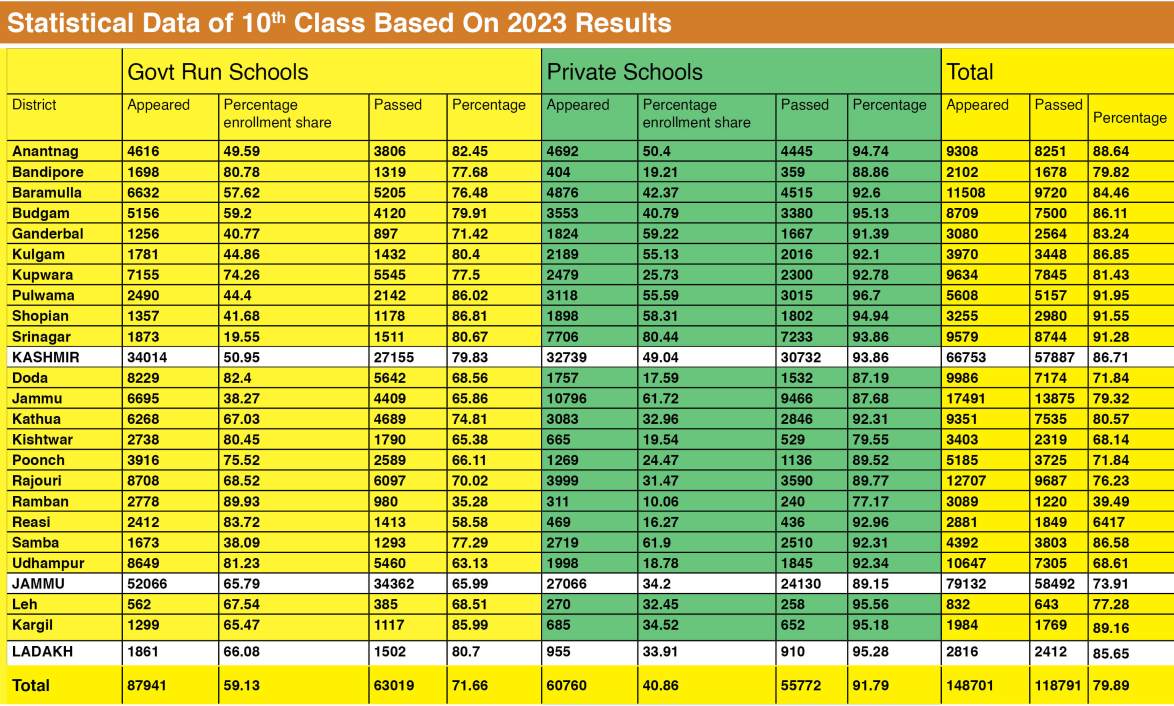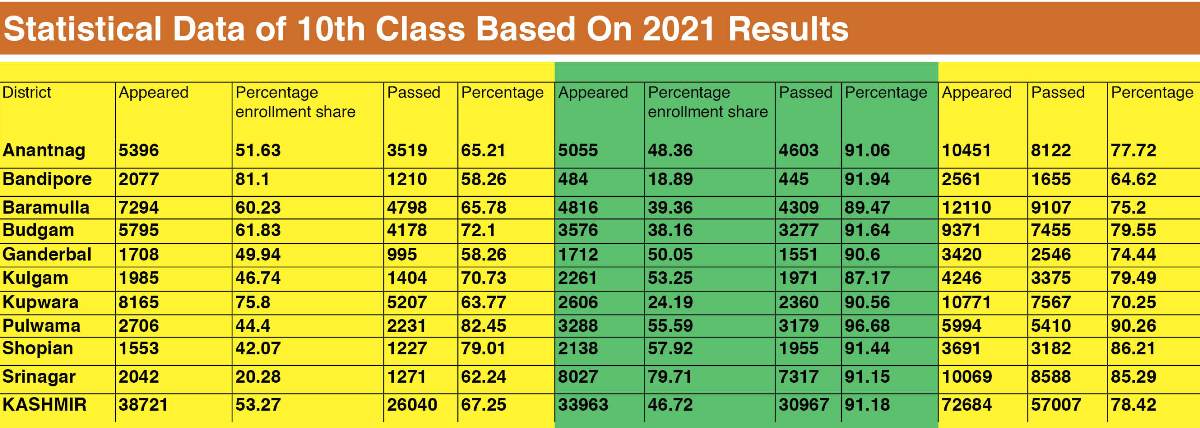In the first pan-Jammu, Kashmir Ladakh BOSE results for the tenth class, data speaks so loudly about the changes silently taking place in the school education sector, Masood Hussain and Faiqa Masoodi report
Regardless of the politics and the situation, Jammu and Kashmir’s school education setup is undergoing a massive change. Although the results of the tenth class, which were made public by the Jammu and Kashmir Board of School Education (BOSE) on June 19, 2023, are not a major parameter for assessing the changes, they provide broad hints and offer an idea about the undercurrents and the potential impact in the near future.
These results were the first consolidated exercise involving all three regions of the former state of Jammu and Kashmir for the NCERT syllabus, which remains the most prevalent curriculum in the region. The consolidated result was the outcome of the single academic calendar that was enforced last year, providing students – for the first time – 12 to 15 months of preparation time for their examinations, an exercise that would normally conclude in the usual 12 months.
The results provided a comprehensive overview of the state of education across Jammu and Kashmir. Previously, the division between the summer and winter zones would result in two separate result sheets and different merit lists. That is now the past.

The Overall Picture
The matriculation results have highlighted Ramban district as one of the academically weakest areas in terms of education. This hilly district, located between two major tunnels on the Jammu Srinagar national highway, is vast, yet only 3089 students were able to take the tenth class examination. The situation worsens when considering that only 1220 students passed, accounting for a meagre pass percentage of 39.49 per cent.
While the district that has witnessed massive developmental activities, such as railways and the highway, over the past decade ranks as the worst performer academically, other districts have also performed poorly. The neighbouring Reasi district plays second fiddle to Ramban. The best-performing districts in the Jammu region are Samba, followed by Kathua and Jammu.
In terms of the Kashmir region, it is performing better overall. The district with the lowest pass percentage is Bandipore with 79.82 per cent. In Jammu, the district with the highest pass percentage is Samba with 86.58 per cent.
This is the first time that the state of education in the Jammu region has come to the public’s attention in comparison to Kashmir and Ladakh. Statistics based on regions suggest that Kashmir tops with 86.71 per cent of pass candidates, followed by Ladakh with 85.65 per cent, and Jammu at the bottom with 73.91 per cent.
Interestingly, Jammu is sending more students compared to Kashmir. In Kashmir, only 66753 students wrote their tenth class examination, whereas the Jammu region sent 79132 students. Despite Kashmir’s higher population and fertility rates, the faking numbers suggest that more young boys and girls may be dropping out before reaching the tenth standard, unlike in Jammu.
Another interesting aspect is that Kargil is sending more than double the number of students compared to its sister district of Leh. Out of the 2816 students who appeared for the examination in 2023, 1984 were from Kargil. Interestingly, Kargil achieved a better pass percentage of 89.16 per cent compared to Leh’s 77.28 per cent. The scarcely populated Leh and Kargil districts form the arid union territory of Ladakh.

Kashmir Scenario
Comparing the data from the last three consecutive results reveals an interesting story about the state of education in Kashmir. For the past three years, the twin districts of south Kashmir have consistently topped in terms of merit.
In 2020, Shopian and Pulwama achieved a pass percentage of 88.2 per cent and 84.25 per cent respectively, while Srinagar secured the third position with 80.7 per cent. In 2021, Pulwama topped with 90.26 per cent, Shopian with 86.21 per cent, and Srinagar retained its third position with 85.29 per cent. In the recently released 2023 results, Pulwama scored 91.95 per cent, Shopian achieved 91.55 per cent, and Srinagar attained 91.28 per cent.
Bandipora, the belt referred to in folklore as the district of Alim, Adab teh Aab (knowledge, literature, and water), continues to be the worst-performing district in terms of scores. In the latest results, its pass percentage was 79.82 per cent, the lowest in Kashmir. In 2021, it scored 62.62 per cent, the lowest, and in 2020, it scored 61.52 per cent.
Residents believe that well-educated individuals acquire education and rarely look back. Bandipora is the number one district where people prefer government schools, and the number of students enrolled in private schools has yet to cross a triple-digit number. This may be influenced by the economic situation of the people living in distant Gurez or along the banks of Wular Lake.
The Larger Story
The most important revelation is that the government school system is effectively losing ground to the private sector. This decline is more noticeable now compared to five years ago, and although the trend exists across Jammu and Kashmir, it is more pronounced in Kashmir.
In the 2020 results, 54.60 per cent of the students who appeared for the examination were enrolled in government-run schools. In 2021, this percentage dropped to 53.27 per cent, and in the recently released 2023 list, it further decreased to 50.95 per cent.
Over the past three academic years, the government-run school education system has lost 3.65 per cent of its overall share, which is a significant figure. During the same period, the share of privately-run schools increased from 45.39 per cent to 49.04 per cent.
To put this trend into simpler terms, six out of Kashmir’s ten districts do not trust the state-run education system. In Jammu, there are eight districts that send their children to state-run schools, unlike in Kashmir, but the trend is changing. The level of trust in the private sector can be explained by the fact that based on tenth-class examination results, 80.44 per cent of students in Srinagar studied in private schools, compared to 59.22 per cent in Ganderbal, 58.31 per cent in Shopian, 55.59 per cent in Pulwama, 55.13 per cent in Kulgam, and 50.4 per cent in Anantnag.
Among the remaining four districts, two are expected to cross the 50 per cent mark in private sector enrolment within the next two to three years.
In the Jammu region, only Jammu City shows a preference for the private sector, with 61.72 per cent of students attending private schools. All other areas, including Ladakh, prefer the public sector. This could be attributed to either the better quality of education in state-run schools or the lack of resources among the population to afford private-sector education. It is also possible that the private educational sector does not exist in certain areas.
After all, privately-run schools tend to perform better. The public sector schools can never match the performance of the private sector, even though the latter may have less skilled and not-so-well-read staff, and they manage to operate with less than 15 per cent of the government’s education budget. Overall, 40.86 per cent of tenth-class students from the private sector across Jammu, Kashmir, and Ladakh are achieving remarkable results, consistently above 90 per cent. In contrast, the highest pass percentage in the public sector for 2023 was 71 per cent.

Declining Numbers
An interesting revelation is that the number of students taking the tenth-class examination in Kashmir is decreasing. In 2020, the total number of Kashmiri students counted in examination centres was 75132. This number dropped to 72684 in 2021, and in 2023, it decreased further to 66733. A net decrease of 8399 students in three academic years warrants investigation.
Could emerging poverty be pushing students to drop out of the system? Are teachers in schools preventing them from appearing in examinations due to the fear that poor results will reflect negatively on their job prospects? Or is there another story waiting to be unveiled?
Simple Forecasting
The data indicate opportunities to fill the void. Evaluation of the data suggests that all districts in Kashmir, except Shopian, are gradually transitioning to the private sector. Ganderbal tops the list with a staggering 14.75 per cent of students leaving the government school system for the private sector over the past three years. This represents a quantum leap.
| Share of Students in 10th Class In Three Academics Years | ||||||
| 2020 | 2021 | 2023 | ||||
| District | Govt | Private | Govt | Private | Govt | Private |
| Anantnag | 55.06 | 44.93 | 51.63 | 48.36 | 49.59 | 50.4 |
| Bandipore | 83.8 | 16.19 | 81.1 | 18.89 | 80.78 | 19.21 |
| Baramulla | 60.54 | 39.45 | 60.23 | 39.36 | 57.62 | 42.37 |
| Budgam | 64.81 | 35.18 | 61.83 | 38.16 | 59.2 | 40.79 |
| Ganderbal | 55.52 | 44.47 | 49.94 | 50.05 | 40.77 | 59.22 |
| Kulgam | 47.55 | 52.44 | 46.74 | 53.25 | 44.86 | 55.13 |
| Kupwara | 74.92 | 25.07 | 75.8 | 24.19 | 74.26 | 25.73 |
| Pulwama | 47.49 | 52.5 | 44.4 | 55.59 | 44.4 | 55.59 |
| Shopian | 40.34 | 59.65 | 42.07 | 57.92 | 41.68 | 58.31 |
| Srinagar | 20.99 | 79 | 20.28 | 79.71 | 19.55 | 80.44 |
| KASHMIR | 54.6 | 45.39 | 53.27 | 46.72 | 50.95 | 49.04 |
The other two districts following Ganderbal are Budgam (5.61 per cent) and Anantnag (5.47 per cent). Shopian, on the other hand, witnessed a reversal where the private sector lost 1.34 per cent of its enrolment to public sector schools. Kupwara reported the smallest changes, with government schools losing only a marginal 0.66 per cent.
This essentially means that the districts most in need of investment in the budget sector private schools include Kupwara and Bandipora. Srinagar, on the whole, is reaching saturation.
However, Srinagar has a significant potential for growth within the educational system. Kashmir faces a significant deficit of +2 schools in the private sector.
These schools must engage in self-introspection and make a fundamental shift. They should continue offering eleventh and twelfth classes to the same students who enrolled prior to the tenth class. The massive and punitive re-admission costs are a key factor pushing students from the private to the public sector. In most of Srinagar’s public sector +2 schools, teachers do not teach; instead, they encourage students to enrol in coaching centres. Once the results are out, they celebrate the “success” that never truly belongs to them. This single change will transform the sector and improve the outcomes.















